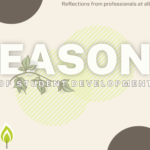Ah Yes! Tis the Season!
As a profession, we are entering (or about to enter) one of the most important seasons of the year, the HIRING Season.
This can be an exciting time for us. As we begin planning for the next academic year, we have the opportunity to implement new initiatives as we hire or select new student staff teams. This season reminds us of when we were students and the general excitement students feel about the opportunity to be involved.As exciting as this time may be, it can also bring some challenges. One of the biggest challenges—particularly for predominantly white Christian institutions—is hiring a diverse staff. In the face of this challenge, and despite good intentions, professionals often succumb to one of three pitfalls:
1) A Staff that lacks diversity. Whether it is because the institution or applicant pool “lacks” diversity, the result is the same; a staff that fails to represent our campuses culturally.
2) Hiring Unqualified Students. This pitfall often appears when we believe that we can teach a student who is not a good fit for the role to become good enough at the actual job we want them to apply for to help bolster the diversity of a given staff team. We ignore the interview and qualifications that a student may have, only to realize that the student does not fit the role we want to hire them for, but we recruit and hire them regardless of their qualifications while holding these students with the same expectations. A natural consequence forces supervisors to ignore what the student brings beyond diversity, so their actual contributions are limited. In addition to burnout, students may also feel a sense of what Claude Steele calls a “stereotype threat” (Whistling Vivaldi). Steele notes that stereotype threat forces people to engage in an environment where they must combat negative stereotypes about themselves while also being expected to perform, which often leads to underperformance.
3) Mismanagement of Minority Students. This pitfall can be seen in the tendency to overuse the same students to support our efforts to have a diverse staff. We ask the same student to get involved in different activities and clubs or to promote a sense of diversity through our advertisements. This can lead a student to become overinvolved and also place them on the path to burnt out.
Avoiding these pitfalls can be difficult but acknowledging their existence can be a step that allows us to work toward better solutions.
In order to avoid the pitfalls we must maintain our commitment to diversity and our care for students together. Here are six critical things to consider as you seek to hire/select diverse student teams this Spring:
1) Evaluate your why
Ultimately, hiring a diverse staff for the sake of hiring a diverse staff is disingenuous and ultimately pointless. At a minimum you would like for your staff to have the same demographic of your institution, but if hiring a diverse staff does not lead to engaging the needs of your underreported students, then your efforts will only lead to quantitative goals being met.
2) Look at language surrounding religious buzzwords that may be regionally or culturally situated.
For example, a team I was a part of asked students to explain the gospel. We found that many of our students of color identified hearing the word ‘gospel’ as a form of expression in music. Our staff members did not recognize that cultural difference and painted them as ‘immature’ in their faith when all they did was discuss music. As a result of this cultural difference, many students were not hired.
3) Include DEI personnel in the planning and implementation process.
Staff members with DEI training are often educated on how to pinpoint practices deemed unfair, inequitable, or prejudiced.
4) Diversify recruiting strategies.
Use a variety of advertising strategies so that different student groups feel like they are wanted and welcome to apply. For example, language and what students may see visually may attract specific demographics. Tailoring our recruiting efforts is essential to our overall goals.
5) Evaluate job descriptions.
Reflect on how you’ve described your positions to reflect the needs of underrepresented students. Often job descriptions serve students under the age-old adage “the needs of the many outweigh the needs of the few,” which often leads to unmet needs of underrepresented students. Even if our pool does not expand in diversity, updated job descriptions help all candidates understand that addressing the needs of our minority students is essential.
6) Enhance practices that help address the needs of underrepresented student groups on campus.
Hiring a diverse staff is a crucial step in meeting the needs of underrepresented student groups because it puts them in leadership positions. However, relying on a diverse student staff to address those needs can be considered malpractice if the sponsors/supervisors of those groups neglect those needs from an administrative level. Engaging in those conversations and making those changes ultimately creates positive and sustainable practices. The lack of sustainable practices does not give students faith in the institution we want them to participate in.
When it comes to addressing the needs of our underrepresented students, representation matters. Taking the necessary steps to address representation issues on our campuses is one of the most crucial steps in engaging the needs of our underrepresented students and moving our campus forward in positive ways. However, it is not just hiring a diverse staff that is important. What may be even more important is investing time in students and practices that address the needs of underrepresented students themselves.







